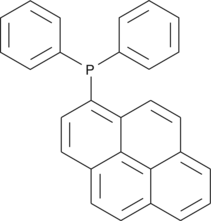Cayman
Showing 19051–19200 of 45550 results
-
DPPI 1c is an inhibitor of dipeptidyl peptidase 4 (DPP-4; IC50 = 104 nM in an enzyme assay).{45967} It decreases plasma glucose levels by 46 to 67% in an oral glucose challenge in fasted, diabetic KK/H1J mice when administered at doses ranging from 0.3 to 5 mg/kg. DPPI 1c decreases plasma DPP-4 activity by approximately 50% and increases plasma glucagon-like peptide 1 (GLP-1) levels in KK/H1J mice.
Brand:CaymanSKU:30211 - 5 mgAvailable on backorder
DPPI 1c is an inhibitor of dipeptidyl peptidase 4 (DPP-4; IC50 = 104 nM in an enzyme assay).{45967} It decreases plasma glucose levels by 46 to 67% in an oral glucose challenge in fasted, diabetic KK/H1J mice when administered at doses ranging from 0.3 to 5 mg/kg. DPPI 1c decreases plasma DPP-4 activity by approximately 50% and increases plasma glucagon-like peptide 1 (GLP-1) levels in KK/H1J mice.
Brand:CaymanSKU:30211 - 500 µgAvailable on backorder
DPPP is a probe that reacts stoichiometrically with hydroperoxides to yield the fluorescent molecule diphenyl-1-pyrenylphosphine oxide (DPPP-O).{9333} Plasma levels of lipid hydroperoxides of phosphatidylcholine, phosphatidylethanolamine, triglycerides, and cholesteryl esters have been measured by HPLC with a post column detection system using DPPP.{14241,14242} DPPP has also been used as a fluorescent probe for the detection of low-density lipoprotein and cellular oxidation.{14248} Fluorescence of DPPP-O can be monitor using excitation and emission wavelengths of 351 nm and 380 nm, respectively.
Brand:CaymanSKU:62237 - 10 mgAvailable on backorder
DPPP is a probe that reacts stoichiometrically with hydroperoxides to yield the fluorescent molecule diphenyl-1-pyrenylphosphine oxide (DPPP-O).{9333} Plasma levels of lipid hydroperoxides of phosphatidylcholine, phosphatidylethanolamine, triglycerides, and cholesteryl esters have been measured by HPLC with a post column detection system using DPPP.{14241,14242} DPPP has also been used as a fluorescent probe for the detection of low-density lipoprotein and cellular oxidation.{14248} Fluorescence of DPPP-O can be monitor using excitation and emission wavelengths of 351 nm and 380 nm, respectively.
Brand:CaymanSKU:62237 - 25 mgAvailable on backorder
DPPP is a probe that reacts stoichiometrically with hydroperoxides to yield the fluorescent molecule diphenyl-1-pyrenylphosphine oxide (DPPP-O).{9333} Plasma levels of lipid hydroperoxides of phosphatidylcholine, phosphatidylethanolamine, triglycerides, and cholesteryl esters have been measured by HPLC with a post column detection system using DPPP.{14241,14242} DPPP has also been used as a fluorescent probe for the detection of low-density lipoprotein and cellular oxidation.{14248} Fluorescence of DPPP-O can be monitor using excitation and emission wavelengths of 351 nm and 380 nm, respectively.
Brand:CaymanSKU:62237 - 5 mgAvailable on backorder
DPPP is a probe that reacts stoichiometrically with hydroperoxides to yield the fluorescent molecule diphenyl-1-pyrenylphosphine oxide (DPPP-O).{9333} Plasma levels of lipid hydroperoxides of phosphatidylcholine, phosphatidylethanolamine, triglycerides, and cholesteryl esters have been measured by HPLC with a post column detection system using DPPP.{14241,14242} DPPP has also been used as a fluorescent probe for the detection of low-density lipoprotein and cellular oxidation.{14248} Fluorescence of DPPP-O can be monitor using excitation and emission wavelengths of 351 nm and 380 nm, respectively.
Brand:CaymanSKU:62237 - 50 mgAvailable on backorder
The poly(ADP-ribose) polymerases (PARPs) form a family of enzymes with roles in DNA repair and apoptosis, particularly in response to reactive oxygen and nitrogen species.{22577,22591} DPQ is a potent inhibitor of PARPs, inhibiting PARP1 with an IC50 value of 40 nM.{22586} It is approximately 10-fold less potent against PARP2.{22587} DPQ can be used in either cells or in animals.{22588,22589}
Brand:CaymanSKU:-The poly(ADP-ribose) polymerases (PARPs) form a family of enzymes with roles in DNA repair and apoptosis, particularly in response to reactive oxygen and nitrogen species.{22577,22591} DPQ is a potent inhibitor of PARPs, inhibiting PARP1 with an IC50 value of 40 nM.{22586} It is approximately 10-fold less potent against PARP2.{22587} DPQ can be used in either cells or in animals.{22588,22589}
Brand:CaymanSKU:-DprE1-IN-2 is an antitubercular agent that is active against M. tuberculosis in vitro, with MIC values ranging from 0.5 to 1.56 μM.{32839} It is an inhibitor of decaprenylphosphoryl-β-D-ribose 2′-epimerase (DprE1; IC50 = 32 nM), an enzyme involved in mycobacterial cell wall biogenesis. DrpE1-IN-2 (300 mg/kg) reduces lung bacterial burden in a mouse model of chronic tuberculosis infection and exhibits a synergistic effect when administered in combination with TMC207 (Item No. 20247).
Brand:CaymanSKU:21034 -Out of stock
DprE1-IN-2 is an antitubercular agent that is active against M. tuberculosis in vitro, with MIC values ranging from 0.5 to 1.56 μM.{32839} It is an inhibitor of decaprenylphosphoryl-β-D-ribose 2′-epimerase (DprE1; IC50 = 32 nM), an enzyme involved in mycobacterial cell wall biogenesis. DrpE1-IN-2 (300 mg/kg) reduces lung bacterial burden in a mouse model of chronic tuberculosis infection and exhibits a synergistic effect when administered in combination with TMC207 (Item No. 20247).
Brand:CaymanSKU:21034 -Out of stock
DprE1-IN-2 is an antitubercular agent that is active against M. tuberculosis in vitro, with MIC values ranging from 0.5 to 1.56 μM.{32839} It is an inhibitor of decaprenylphosphoryl-β-D-ribose 2′-epimerase (DprE1; IC50 = 32 nM), an enzyme involved in mycobacterial cell wall biogenesis. DrpE1-IN-2 (300 mg/kg) reduces lung bacterial burden in a mouse model of chronic tuberculosis infection and exhibits a synergistic effect when administered in combination with TMC207 (Item No. 20247).
Brand:CaymanSKU:21034 -Out of stock
DprE1-IN-2 is an antitubercular agent that is active against M. tuberculosis in vitro, with MIC values ranging from 0.5 to 1.56 μM.{32839} It is an inhibitor of decaprenylphosphoryl-β-D-ribose 2′-epimerase (DprE1; IC50 = 32 nM), an enzyme involved in mycobacterial cell wall biogenesis. DrpE1-IN-2 (300 mg/kg) reduces lung bacterial burden in a mouse model of chronic tuberculosis infection and exhibits a synergistic effect when administered in combination with TMC207 (Item No. 20247).
Brand:CaymanSKU:21034 -Out of stock
DPT (hydrochloride) is a psychedelic drug of the tryptamine class. It inhibits the re-uptake of dopamine, serotonin, and norepinephrine (IC50s = 23, 2.9, and 9.1 μM).{19758} This product is intended for forensic and research applications.
Brand:CaymanSKU:11551 - 10 mgAvailable on backorder
DPT (hydrochloride) is a psychedelic drug of the tryptamine class. It inhibits the re-uptake of dopamine, serotonin, and norepinephrine (IC50s = 23, 2.9, and 9.1 μM).{19758} This product is intended for forensic and research applications.
Brand:CaymanSKU:11551 - 25 mgAvailable on backorder
DPT (hydrochloride) is a psychedelic drug of the tryptamine class. It inhibits the re-uptake of dopamine, serotonin, and norepinephrine (IC50s = 23, 2.9, and 9.1 μM).{19758} This product is intended for forensic and research applications.
Brand:CaymanSKU:11551 - 5 mgAvailable on backorder
DPTA NONOate is a NO donor. It spontaneously dissociates in a pH-dependent, first-order process with a half-life of three hours and five hours at 37°C and 22-25°C, pH 7.4, respectively, to liberate 2 moles of NO per mole of parent compound.{1190,5437}
Brand:CaymanSKU:82110 - 10 mgAvailable on backorder
DPTA NONOate is a NO donor. It spontaneously dissociates in a pH-dependent, first-order process with a half-life of three hours and five hours at 37°C and 22-25°C, pH 7.4, respectively, to liberate 2 moles of NO per mole of parent compound.{1190,5437}
Brand:CaymanSKU:82110 - 100 mgAvailable on backorder
DPTA NONOate is a NO donor. It spontaneously dissociates in a pH-dependent, first-order process with a half-life of three hours and five hours at 37°C and 22-25°C, pH 7.4, respectively, to liberate 2 moles of NO per mole of parent compound.{1190,5437}
Brand:CaymanSKU:82110 - 25 mgAvailable on backorder
DPTA NONOate is a NO donor. It spontaneously dissociates in a pH-dependent, first-order process with a half-life of three hours and five hours at 37°C and 22-25°C, pH 7.4, respectively, to liberate 2 moles of NO per mole of parent compound.{1190,5437}
Brand:CaymanSKU:82110 - 50 mgAvailable on backorder
DQP1105 is an NMDA receptor antagonist.{52769} It selectively inhibits glutamate-induced currents in Xenopus oocytes expressing rat NR2C and NR2D subunit-containing NMDA receptors (IC50s = 8.5 and 2.7 µM, respectively) over NR2A, NR2B, NRA1, and NRK2 subunit-containing receptors (IC50s = 206, 121, 198, and 153 µM, respectively).
Brand:CaymanSKU:31121 - 1 mgAvailable on backorder
DQP1105 is an NMDA receptor antagonist.{52769} It selectively inhibits glutamate-induced currents in Xenopus oocytes expressing rat NR2C and NR2D subunit-containing NMDA receptors (IC50s = 8.5 and 2.7 µM, respectively) over NR2A, NR2B, NRA1, and NRK2 subunit-containing receptors (IC50s = 206, 121, 198, and 153 µM, respectively).
Brand:CaymanSKU:31121 - 10 mgAvailable on backorder
DQP1105 is an NMDA receptor antagonist.{52769} It selectively inhibits glutamate-induced currents in Xenopus oocytes expressing rat NR2C and NR2D subunit-containing NMDA receptors (IC50s = 8.5 and 2.7 µM, respectively) over NR2A, NR2B, NRA1, and NRK2 subunit-containing receptors (IC50s = 206, 121, 198, and 153 µM, respectively).
Brand:CaymanSKU:31121 - 5 mgAvailable on backorder
DR2313 is an inhibitor of poly(ADP-ribose) polymerase (PARP; IC50 = 0.2 and 0.24 µM for PARP1 and PARP2, respectively, in nuclear rat brain extracts).{34502} It is selective for PARP, with no effect on GAPDH, ADH, LDH, or on lipid peroxidation. DR2313 is competitive with NAD+ at the catalytic site of PARP with a Ki value of 0.23 µM. Pretreatment of primary rat cortical cultures prevents cell death (EC50 = 0.27 µM), and, in vivo, it reduces infarct volume in a rat model of cerebral ischemia. DR2313 has been used to investigate cell death after middle cerebral artery occlusion.{34503}
Brand:CaymanSKU:21181 -Out of stock
DR2313 is an inhibitor of poly(ADP-ribose) polymerase (PARP; IC50 = 0.2 and 0.24 µM for PARP1 and PARP2, respectively, in nuclear rat brain extracts).{34502} It is selective for PARP, with no effect on GAPDH, ADH, LDH, or on lipid peroxidation. DR2313 is competitive with NAD+ at the catalytic site of PARP with a Ki value of 0.23 µM. Pretreatment of primary rat cortical cultures prevents cell death (EC50 = 0.27 µM), and, in vivo, it reduces infarct volume in a rat model of cerebral ischemia. DR2313 has been used to investigate cell death after middle cerebral artery occlusion.{34503}
Brand:CaymanSKU:21181 -Out of stock
DR2313 is an inhibitor of poly(ADP-ribose) polymerase (PARP; IC50 = 0.2 and 0.24 µM for PARP1 and PARP2, respectively, in nuclear rat brain extracts).{34502} It is selective for PARP, with no effect on GAPDH, ADH, LDH, or on lipid peroxidation. DR2313 is competitive with NAD+ at the catalytic site of PARP with a Ki value of 0.23 µM. Pretreatment of primary rat cortical cultures prevents cell death (EC50 = 0.27 µM), and, in vivo, it reduces infarct volume in a rat model of cerebral ischemia. DR2313 has been used to investigate cell death after middle cerebral artery occlusion.{34503}
Brand:CaymanSKU:21181 -Out of stock
DR2313 is an inhibitor of poly(ADP-ribose) polymerase (PARP; IC50 = 0.2 and 0.24 µM for PARP1 and PARP2, respectively, in nuclear rat brain extracts).{34502} It is selective for PARP, with no effect on GAPDH, ADH, LDH, or on lipid peroxidation. DR2313 is competitive with NAD+ at the catalytic site of PARP with a Ki value of 0.23 µM. Pretreatment of primary rat cortical cultures prevents cell death (EC50 = 0.27 µM), and, in vivo, it reduces infarct volume in a rat model of cerebral ischemia. DR2313 has been used to investigate cell death after middle cerebral artery occlusion.{34503}
Brand:CaymanSKU:21181 -Out of stock
Dracorhodin perchlorate is a pro-apoptotic compound and a synthetic analog of dracorhodin, an anthocyanin that has been found in D. draco fruit.{48435,48436} It induces cell cycle arrest at the G0/G1 phase as well as apoptosis in U87MG and T98G glioma cells when used at concentrations of 40 and 80 μM.{48436} It also increases levels of p53, p21, Bim, and Bax and decreases levels of Bcl-2 in glioma cells in vitro. Dracorhodin perchlorate is cytotoxic to U937, A375-S2, and MCF-7 cells in a concentration-dependent manner.{48435} It is also cytotoxic to HeLa cells, an effect that can be reversed by Ac-YVAD-CMK (Item No. 10014), Z-DEVD-FMK (Item No. 14414), Z-IETD-FMK, and Z-LEHD-FMK, which are inhibitors of caspase-1, -3, -8, and -9, respectively.
Brand:CaymanSKU:27294 - 100 mgAvailable on backorder
Dracorhodin perchlorate is a pro-apoptotic compound and a synthetic analog of dracorhodin, an anthocyanin that has been found in D. draco fruit.{48435,48436} It induces cell cycle arrest at the G0/G1 phase as well as apoptosis in U87MG and T98G glioma cells when used at concentrations of 40 and 80 μM.{48436} It also increases levels of p53, p21, Bim, and Bax and decreases levels of Bcl-2 in glioma cells in vitro. Dracorhodin perchlorate is cytotoxic to U937, A375-S2, and MCF-7 cells in a concentration-dependent manner.{48435} It is also cytotoxic to HeLa cells, an effect that can be reversed by Ac-YVAD-CMK (Item No. 10014), Z-DEVD-FMK (Item No. 14414), Z-IETD-FMK, and Z-LEHD-FMK, which are inhibitors of caspase-1, -3, -8, and -9, respectively.
Brand:CaymanSKU:27294 - 25 mgAvailable on backorder
Dracorhodin perchlorate is a pro-apoptotic compound and a synthetic analog of dracorhodin, an anthocyanin that has been found in D. draco fruit.{48435,48436} It induces cell cycle arrest at the G0/G1 phase as well as apoptosis in U87MG and T98G glioma cells when used at concentrations of 40 and 80 μM.{48436} It also increases levels of p53, p21, Bim, and Bax and decreases levels of Bcl-2 in glioma cells in vitro. Dracorhodin perchlorate is cytotoxic to U937, A375-S2, and MCF-7 cells in a concentration-dependent manner.{48435} It is also cytotoxic to HeLa cells, an effect that can be reversed by Ac-YVAD-CMK (Item No. 10014), Z-DEVD-FMK (Item No. 14414), Z-IETD-FMK, and Z-LEHD-FMK, which are inhibitors of caspase-1, -3, -8, and -9, respectively.
Brand:CaymanSKU:27294 - 250 mgAvailable on backorder
Dracorhodin perchlorate is a pro-apoptotic compound and a synthetic analog of dracorhodin, an anthocyanin that has been found in D. draco fruit.{48435,48436} It induces cell cycle arrest at the G0/G1 phase as well as apoptosis in U87MG and T98G glioma cells when used at concentrations of 40 and 80 μM.{48436} It also increases levels of p53, p21, Bim, and Bax and decreases levels of Bcl-2 in glioma cells in vitro. Dracorhodin perchlorate is cytotoxic to U937, A375-S2, and MCF-7 cells in a concentration-dependent manner.{48435} It is also cytotoxic to HeLa cells, an effect that can be reversed by Ac-YVAD-CMK (Item No. 10014), Z-DEVD-FMK (Item No. 14414), Z-IETD-FMK, and Z-LEHD-FMK, which are inhibitors of caspase-1, -3, -8, and -9, respectively.
Brand:CaymanSKU:27294 - 50 mgAvailable on backorder
DRB is a nucleoside analog that inhibits several carboxyl-terminal domain (CTD) kinases including casein kinase II (IC50 range of 4-10 µM){15211}, Cdk7 (IC50 = ~20 µM){15209,15207}, Cdk8 (IC50 = ~20 µM){15207}, and Cdk9 (IC50 = 3 µM).{15214} Through inhibition of certain CTD kinases, DRB inhibits an elongation step during RNA polymerase II transcription{15210,15208}, which can trigger p53-dependent apoptosis of human colon adenocarcinoma cells without inducing genotoxic stress to healthy cells.{15213} DRB can also inhibit HIV transcription (IC50 = ~4 µM) by targeting elongation enhanced by the HIV-encoded transactivator Tat.{15212}
Brand:CaymanSKU:10010302 - 10 mgAvailable on backorder
DRB is a nucleoside analog that inhibits several carboxyl-terminal domain (CTD) kinases including casein kinase II (IC50 range of 4-10 µM){15211}, Cdk7 (IC50 = ~20 µM){15209,15207}, Cdk8 (IC50 = ~20 µM){15207}, and Cdk9 (IC50 = 3 µM).{15214} Through inhibition of certain CTD kinases, DRB inhibits an elongation step during RNA polymerase II transcription{15210,15208}, which can trigger p53-dependent apoptosis of human colon adenocarcinoma cells without inducing genotoxic stress to healthy cells.{15213} DRB can also inhibit HIV transcription (IC50 = ~4 µM) by targeting elongation enhanced by the HIV-encoded transactivator Tat.{15212}
Brand:CaymanSKU:10010302 - 100 mgAvailable on backorder
DRB is a nucleoside analog that inhibits several carboxyl-terminal domain (CTD) kinases including casein kinase II (IC50 range of 4-10 µM){15211}, Cdk7 (IC50 = ~20 µM){15209,15207}, Cdk8 (IC50 = ~20 µM){15207}, and Cdk9 (IC50 = 3 µM).{15214} Through inhibition of certain CTD kinases, DRB inhibits an elongation step during RNA polymerase II transcription{15210,15208}, which can trigger p53-dependent apoptosis of human colon adenocarcinoma cells without inducing genotoxic stress to healthy cells.{15213} DRB can also inhibit HIV transcription (IC50 = ~4 µM) by targeting elongation enhanced by the HIV-encoded transactivator Tat.{15212}
Brand:CaymanSKU:10010302 - 250 mgAvailable on backorder
DRB is a nucleoside analog that inhibits several carboxyl-terminal domain (CTD) kinases including casein kinase II (IC50 range of 4-10 µM){15211}, Cdk7 (IC50 = ~20 µM){15209,15207}, Cdk8 (IC50 = ~20 µM){15207}, and Cdk9 (IC50 = 3 µM).{15214} Through inhibition of certain CTD kinases, DRB inhibits an elongation step during RNA polymerase II transcription{15210,15208}, which can trigger p53-dependent apoptosis of human colon adenocarcinoma cells without inducing genotoxic stress to healthy cells.{15213} DRB can also inhibit HIV transcription (IC50 = ~4 µM) by targeting elongation enhanced by the HIV-encoded transactivator Tat.{15212}
Brand:CaymanSKU:10010302 - 50 mgAvailable on backorder
DREADD agonist 21 activates hM3Dq (EC50 = 1.7 nM), a designer receptor exclusively activated by designer drugs (DREADD) derived from the human muscarinic acetylcholine M3 receptor.{30413} It does not agonize the hM3 receptor and displays relatively weaker binding affinities for serotonin 5-HT2A, 5-HT2C, α1A-adrenergic, and histamine H1 receptors (Kis = 66, 170, 280, and 6 nM, respectively).{30413}
Brand:CaymanSKU:-Available on backorder
DREADD agonist 21 activates hM3Dq (EC50 = 1.7 nM), a designer receptor exclusively activated by designer drugs (DREADD) derived from the human muscarinic acetylcholine M3 receptor.{30413} It does not agonize the hM3 receptor and displays relatively weaker binding affinities for serotonin 5-HT2A, 5-HT2C, α1A-adrenergic, and histamine H1 receptors (Kis = 66, 170, 280, and 6 nM, respectively).{30413}
Brand:CaymanSKU:-Available on backorder
DREADD agonist 21 activates hM3Dq (EC50 = 1.7 nM), a designer receptor exclusively activated by designer drugs (DREADD) derived from the human muscarinic acetylcholine M3 receptor.{30413} It does not agonize the hM3 receptor and displays relatively weaker binding affinities for serotonin 5-HT2A, 5-HT2C, α1A-adrenergic, and histamine H1 receptors (Kis = 66, 170, 280, and 6 nM, respectively).{30413}
Brand:CaymanSKU:-Available on backorder
Drimendiol is a sesquiterpene that has been found in W. ugandensis.{53302} It inhibits C. albicans, S. aureus, and S. epidermidis biofilm formation with 50% biofilm inhibitory concentration values (BIC50s) of 25.5, 65.1, and 67.1 µg/ml, respectively. It has antifouling activity, inhibiting the settlement of C. savignyi and B. improvisus larvae on a petri dish surface (EC50s = 1 and 0.5 µg/ml, respectively).{53303}
Brand:CaymanSKU:29820 - 1 mgAvailable on backorder
Drimendiol is a sesquiterpene that has been found in W. ugandensis.{53302} It inhibits C. albicans, S. aureus, and S. epidermidis biofilm formation with 50% biofilm inhibitory concentration values (BIC50s) of 25.5, 65.1, and 67.1 µg/ml, respectively. It has antifouling activity, inhibiting the settlement of C. savignyi and B. improvisus larvae on a petri dish surface (EC50s = 1 and 0.5 µg/ml, respectively).{53303}
Brand:CaymanSKU:29820 - 5 mgAvailable on backorder
Drimentine A is a terpenylated diketopiperazine antibiotic originally isolated from Actinomycete bacteria.{38990} It is active against Gram-positive and Gram-negative bacteria, fungi, and yeast and has anthelmintic properties.
Brand:CaymanSKU:23495 - 1 mgAvailable on backorder
Drimentine A is a terpenylated diketopiperazine antibiotic originally isolated from Actinomycete bacteria.{38990} It is active against Gram-positive and Gram-negative bacteria, fungi, and yeast and has anthelmintic properties.
Brand:CaymanSKU:23495 - 5 mgAvailable on backorder
Drimentine B is a terpenylated diketopiperazine antibiotic originally isolated from Actinomycete bacteria.{38990} It is active against Gram-positive and Gram-negative bacteria, fungi, and yeast, and has anthelmintic properties. Drimentine B inhibits proliferation of NS-1 murine β lymphocyte myeloma cells by 41 and 59% in vitro when used at concentrations of 50 and 100 µg/ml, respectively.
Brand:CaymanSKU:25451 - 1 mgAvailable on backorder
Drimentine B is a terpenylated diketopiperazine antibiotic originally isolated from Actinomycete bacteria.{38990} It is active against Gram-positive and Gram-negative bacteria, fungi, and yeast, and has anthelmintic properties. Drimentine B inhibits proliferation of NS-1 murine β lymphocyte myeloma cells by 41 and 59% in vitro when used at concentrations of 50 and 100 µg/ml, respectively.
Brand:CaymanSKU:25451 - 5 mgAvailable on backorder
Drimentine C is a terpenylated diketopiperazine antibiotic originally isolated from Actinomycete bacteria.{38990} It inhibits proliferation of NS-1 murine β lymphocyte myeloma cells by 63 and 98% in vitro when used at concentrations of 12.5 and 100 µg/ml, respectively.
Brand:CaymanSKU:25763 - 1 mgAvailable on backorder
Drimentine C is a terpenylated diketopiperazine antibiotic originally isolated from Actinomycete bacteria.{38990} It inhibits proliferation of NS-1 murine β lymphocyte myeloma cells by 63 and 98% in vitro when used at concentrations of 12.5 and 100 µg/ml, respectively.
Brand:CaymanSKU:25763 - 5 mgAvailable on backorder
Dronedarone is an antiarrhythmic agent and a derivative of amiodarone (Item No. 15213).{41032,41033} It inhibits muscarinic acetylcholine receptor-dependent potassium currents induced by carbachol (carbamoylcholine; Item No. 14486) or intracellular loading of GTPγS in single cells isolated from guinea pig atria (IC50s = 0.1 and 1 µM, respectively).{41033} Dronedarone (50 and 100 mg/kg) reduces sinus frequency and prolongs action potential duration (APD) in isolated rabbit ventricular myocardium. It increases atrial APD and the atrial effective refractory period (AERP) in a dog model of atrial fibrillation induced by rapid right atrial pacing.{57286} Formulations containing dronedarone have been used in the treatment of atrial fibrillation.
Brand:CaymanSKU:9000543 - 10 mgAvailable on backorder
Dronedarone is an antiarrhythmic agent and a derivative of amiodarone (Item No. 15213).{41032,41033} It inhibits muscarinic acetylcholine receptor-dependent potassium currents induced by carbachol (carbamoylcholine; Item No. 14486) or intracellular loading of GTPγS in single cells isolated from guinea pig atria (IC50s = 0.1 and 1 µM, respectively).{41033} Dronedarone (50 and 100 mg/kg) reduces sinus frequency and prolongs action potential duration (APD) in isolated rabbit ventricular myocardium. It increases atrial APD and the atrial effective refractory period (AERP) in a dog model of atrial fibrillation induced by rapid right atrial pacing.{57286} Formulations containing dronedarone have been used in the treatment of atrial fibrillation.
Brand:CaymanSKU:9000543 - 100 mgAvailable on backorder
Dronedarone is an antiarrhythmic agent and a derivative of amiodarone (Item No. 15213).{41032,41033} It inhibits muscarinic acetylcholine receptor-dependent potassium currents induced by carbachol (carbamoylcholine; Item No. 14486) or intracellular loading of GTPγS in single cells isolated from guinea pig atria (IC50s = 0.1 and 1 µM, respectively).{41033} Dronedarone (50 and 100 mg/kg) reduces sinus frequency and prolongs action potential duration (APD) in isolated rabbit ventricular myocardium. It increases atrial APD and the atrial effective refractory period (AERP) in a dog model of atrial fibrillation induced by rapid right atrial pacing.{57286} Formulations containing dronedarone have been used in the treatment of atrial fibrillation.
Brand:CaymanSKU:9000543 - 250 mgAvailable on backorder
Dronedarone is an antiarrhythmic agent and a derivative of amiodarone (Item No. 15213).{41032,41033} It inhibits muscarinic acetylcholine receptor-dependent potassium currents induced by carbachol (carbamoylcholine; Item No. 14486) or intracellular loading of GTPγS in single cells isolated from guinea pig atria (IC50s = 0.1 and 1 µM, respectively).{41033} Dronedarone (50 and 100 mg/kg) reduces sinus frequency and prolongs action potential duration (APD) in isolated rabbit ventricular myocardium. It increases atrial APD and the atrial effective refractory period (AERP) in a dog model of atrial fibrillation induced by rapid right atrial pacing.{57286} Formulations containing dronedarone have been used in the treatment of atrial fibrillation.
Brand:CaymanSKU:9000543 - 50 mgAvailable on backorder
Dronedarone-d6 is intended for use as an internal standard for the quantification of dronedarone (Item No. 9000543) by GC- or LC-MS. Dronedarone is an antiarrhythmic agent and a derivative of amiodarone (Item No. 15213).{41032,41033} It inhibits muscarinic acetylcholine receptor-dependent potassium currents induced by carbachol (carbamoylcholine; Item No. 14486) or intracellular loading of GTPγS in single cells isolated from guinea pig atria (IC50s = 0.1 and 1 µM, respectively).{41033} Dronedarone (50 and 100 mg/kg) reduces sinus frequency and prolongs action potential duration (APD) in isolated rabbit ventricular myocardium. It increases atrial APD and the atrial effective refractory period (AERP) in a dog model of atrial fibrillation induced by rapid right atrial pacing.{57286} Formulations containing dronedarone have been used in the treatment of atrial fibrillation.
Brand:CaymanSKU:31787 - 1 mgAvailable on backorder
Droperidol is a butyrophenone that acts as an antagonist at dopamine receptors (Kis = 0.25 and 0.84 nM at human D2 and D4).{30677} It less potently inhibits the human voltage-gated potassium channel (IC50 = 32 nM).{30675} Droperidol has been shown to provide relief from acute migraines and prevent nausea and vomiting in clinical trials.{30676,30674}
Brand:CaymanSKU:-Available on backorder
Droperidol is a butyrophenone that acts as an antagonist at dopamine receptors (Kis = 0.25 and 0.84 nM at human D2 and D4).{30677} It less potently inhibits the human voltage-gated potassium channel (IC50 = 32 nM).{30675} Droperidol has been shown to provide relief from acute migraines and prevent nausea and vomiting in clinical trials.{30676,30674}
Brand:CaymanSKU:-Available on backorder
Droperidol is a butyrophenone that acts as an antagonist at dopamine receptors (Kis = 0.25 and 0.84 nM at human D2 and D4).{30677} It less potently inhibits the human voltage-gated potassium channel (IC50 = 32 nM).{30675} Droperidol has been shown to provide relief from acute migraines and prevent nausea and vomiting in clinical trials.{30676,30674}
Brand:CaymanSKU:-Available on backorder
Droperidol is a butyrophenone that acts as an antagonist at dopamine receptors (Kis = 0.25 and 0.84 nM at human D2 and D4).{30677} It less potently inhibits the human voltage-gated potassium channel (IC50 = 32 nM).{30675} Droperidol has been shown to provide relief from acute migraines and prevent nausea and vomiting in clinical trials.{30676,30674}
Brand:CaymanSKU:-Available on backorder
Dropropizine is an antitussive agent.{56160,56161} It reduces the number and intensity of mechanical irritation-induced coughs in conscious cats when administered at doses of 100 and 30 mg/kg, respectively.
Brand:CaymanSKU:31110 - 10 gAvailable on backorder
Dropropizine is an antitussive agent.{56160,56161} It reduces the number and intensity of mechanical irritation-induced coughs in conscious cats when administered at doses of 100 and 30 mg/kg, respectively.
Brand:CaymanSKU:31110 - 25 gAvailable on backorder
Dropropizine is an antitussive agent.{56160,56161} It reduces the number and intensity of mechanical irritation-induced coughs in conscious cats when administered at doses of 100 and 30 mg/kg, respectively.
Brand:CaymanSKU:31110 - 5 gAvailable on backorder
Dropropizine is an antitussive agent.{56160,56161} It reduces the number and intensity of mechanical irritation-induced coughs in conscious cats when administered at doses of 100 and 30 mg/kg, respectively.
Brand:CaymanSKU:31110 - 50 gAvailable on backorder
Drospirenone is a synthetic progestogen that binds to the progesterone, mineralocorticoid, and androgen receptors with binding affinities of 20, 230, and 65% relative to R5020, aldosterone (Item No. 15273), and R1881, respectively.{41140} In vivo, drospirenone inhibits spontaneous ovulation in rats (ID50s = 0.3-1.0 mg/day) when administered orally or subcutaneously.{41141} Drospirenone (0.5 mg/animal) administered six times per day maintains pregnancy in ovariectomized pregnant rats. It reduces serum testosterone (Item Nos. 15645 | ISO60154) and luteinizing hormone in cynomolgus monkeys in a dose-dependent manner. Drospirenone (10 mg/animal per day) also inhibits testosterone-induced growth of the seminal vesicles and prostate in castrated rats. Formulations containing drospirenone have been used as oral contraceptives.{41142}
Brand:CaymanSKU:23347 - 10 mgAvailable on backorder
Drospirenone is a synthetic progestogen that binds to the progesterone, mineralocorticoid, and androgen receptors with binding affinities of 20, 230, and 65% relative to R5020, aldosterone (Item No. 15273), and R1881, respectively.{41140} In vivo, drospirenone inhibits spontaneous ovulation in rats (ID50s = 0.3-1.0 mg/day) when administered orally or subcutaneously.{41141} Drospirenone (0.5 mg/animal) administered six times per day maintains pregnancy in ovariectomized pregnant rats. It reduces serum testosterone (Item Nos. 15645 | ISO60154) and luteinizing hormone in cynomolgus monkeys in a dose-dependent manner. Drospirenone (10 mg/animal per day) also inhibits testosterone-induced growth of the seminal vesicles and prostate in castrated rats. Formulations containing drospirenone have been used as oral contraceptives.{41142}
Brand:CaymanSKU:23347 - 100 mgAvailable on backorder
Drospirenone is a synthetic progestogen that binds to the progesterone, mineralocorticoid, and androgen receptors with binding affinities of 20, 230, and 65% relative to R5020, aldosterone (Item No. 15273), and R1881, respectively.{41140} In vivo, drospirenone inhibits spontaneous ovulation in rats (ID50s = 0.3-1.0 mg/day) when administered orally or subcutaneously.{41141} Drospirenone (0.5 mg/animal) administered six times per day maintains pregnancy in ovariectomized pregnant rats. It reduces serum testosterone (Item Nos. 15645 | ISO60154) and luteinizing hormone in cynomolgus monkeys in a dose-dependent manner. Drospirenone (10 mg/animal per day) also inhibits testosterone-induced growth of the seminal vesicles and prostate in castrated rats. Formulations containing drospirenone have been used as oral contraceptives.{41142}
Brand:CaymanSKU:23347 - 250 mgAvailable on backorder
Drospirenone is a synthetic progestogen that binds to the progesterone, mineralocorticoid, and androgen receptors with binding affinities of 20, 230, and 65% relative to R5020, aldosterone (Item No. 15273), and R1881, respectively.{41140} In vivo, drospirenone inhibits spontaneous ovulation in rats (ID50s = 0.3-1.0 mg/day) when administered orally or subcutaneously.{41141} Drospirenone (0.5 mg/animal) administered six times per day maintains pregnancy in ovariectomized pregnant rats. It reduces serum testosterone (Item Nos. 15645 | ISO60154) and luteinizing hormone in cynomolgus monkeys in a dose-dependent manner. Drospirenone (10 mg/animal per day) also inhibits testosterone-induced growth of the seminal vesicles and prostate in castrated rats. Formulations containing drospirenone have been used as oral contraceptives.{41142}
Brand:CaymanSKU:23347 - 50 mgAvailable on backorder
Drotaverine is an alkaloid that has been described as an inhibitor of phosphodiesterase 4 and negative allosteric modulator of L-type Ca2+ channels.{33092,33094} Formulations containing drotaverine are used as antispasmodics to help cervical dilation in the early stages of labor.{33093}
Brand:CaymanSKU:20944 -Out of stock
Drotaverine is an alkaloid that has been described as an inhibitor of phosphodiesterase 4 and negative allosteric modulator of L-type Ca2+ channels.{33092,33094} Formulations containing drotaverine are used as antispasmodics to help cervical dilation in the early stages of labor.{33093}
Brand:CaymanSKU:20944 -Out of stock
Drotaverine is an alkaloid that has been described as an inhibitor of phosphodiesterase 4 and negative allosteric modulator of L-type Ca2+ channels.{33092,33094} Formulations containing drotaverine are used as antispasmodics to help cervical dilation in the early stages of labor.{33093}
Brand:CaymanSKU:20944 -Out of stock
Drotaverine is an alkaloid that has been described as an inhibitor of phosphodiesterase 4 and negative allosteric modulator of L-type Ca2+ channels.{33092,33094} Formulations containing drotaverine are used as antispasmodics to help cervical dilation in the early stages of labor.{33093}
Brand:CaymanSKU:20944 -Out of stock
Droxidopa (L-DOPS) is a synthetic precursor and prodrug of the neurotransmitter norepinephrine.{40480} It is transformed into norepinephrine through the action of DOPA decarboxylase. L-DOPS increases norepinephrine levels in the rat heart following intraperitoneal administration and in the brain following intracerebroventricular administration at doses of 125 and 100 µg/animal, respectively. It increases arterial pressure and mesenteric arterial resistance in rats with ligated portal vein or biliary ducts when used at doses of 25-50 mg/kg.{40481} L-DOPS crosses the blood brain barrier, however, its effects can be blocked by the peripherally-restricted DOPA decarboxylase inhibitor carbidopa (Item No. 23783), indicating that the mechanism is peripheral.{40482,40481} Formulations containing droxidopa are used in the treatment of neurogenic orthostatic hypotension.
Brand:CaymanSKU:23779 - 1 mgAvailable on backorder
Droxidopa (L-DOPS) is a synthetic precursor and prodrug of the neurotransmitter norepinephrine.{40480} It is transformed into norepinephrine through the action of DOPA decarboxylase. L-DOPS increases norepinephrine levels in the rat heart following intraperitoneal administration and in the brain following intracerebroventricular administration at doses of 125 and 100 µg/animal, respectively. It increases arterial pressure and mesenteric arterial resistance in rats with ligated portal vein or biliary ducts when used at doses of 25-50 mg/kg.{40481} L-DOPS crosses the blood brain barrier, however, its effects can be blocked by the peripherally-restricted DOPA decarboxylase inhibitor carbidopa (Item No. 23783), indicating that the mechanism is peripheral.{40482,40481} Formulations containing droxidopa are used in the treatment of neurogenic orthostatic hypotension.
Brand:CaymanSKU:23779 - 10 mgAvailable on backorder
Droxidopa (L-DOPS) is a synthetic precursor and prodrug of the neurotransmitter norepinephrine.{40480} It is transformed into norepinephrine through the action of DOPA decarboxylase. L-DOPS increases norepinephrine levels in the rat heart following intraperitoneal administration and in the brain following intracerebroventricular administration at doses of 125 and 100 µg/animal, respectively. It increases arterial pressure and mesenteric arterial resistance in rats with ligated portal vein or biliary ducts when used at doses of 25-50 mg/kg.{40481} L-DOPS crosses the blood brain barrier, however, its effects can be blocked by the peripherally-restricted DOPA decarboxylase inhibitor carbidopa (Item No. 23783), indicating that the mechanism is peripheral.{40482,40481} Formulations containing droxidopa are used in the treatment of neurogenic orthostatic hypotension.
Brand:CaymanSKU:23779 - 25 mgAvailable on backorder
Droxidopa (L-DOPS) is a synthetic precursor and prodrug of the neurotransmitter norepinephrine.{40480} It is transformed into norepinephrine through the action of DOPA decarboxylase. L-DOPS increases norepinephrine levels in the rat heart following intraperitoneal administration and in the brain following intracerebroventricular administration at doses of 125 and 100 µg/animal, respectively. It increases arterial pressure and mesenteric arterial resistance in rats with ligated portal vein or biliary ducts when used at doses of 25-50 mg/kg.{40481} L-DOPS crosses the blood brain barrier, however, its effects can be blocked by the peripherally-restricted DOPA decarboxylase inhibitor carbidopa (Item No. 23783), indicating that the mechanism is peripheral.{40482,40481} Formulations containing droxidopa are used in the treatment of neurogenic orthostatic hypotension.
Brand:CaymanSKU:23779 - 5 mgAvailable on backorder
Droxinostat is an inhibitor of histone deacetylase (HDAC) 3, 6, and 8 (IC50s = 16.9, 2.47, and 1.46 μM, respectively).{38617} It is selective for HDAC3, 6, and 8 over HDAC1, 2, 7, 9, and 10 (IC50s = >20 μM). Droxinostat increases histone H3 and H4 acetylation in PPC-1 prostate, OVCAR3 ovarian, U937 leukemia, HT-29 colon, and T47D breast cancer cells. It also inhibits proliferation and colony formation of SMMC-7721 and HepG2 hepatocellular carcinoma cell lines via activation of mitochondrial apoptosis and reduction of cellular FLICE-inhibitory protein (c-FLIP).{38618}
Brand:CaymanSKU:23869 - 1 mgAvailable on backorder
Droxinostat is an inhibitor of histone deacetylase (HDAC) 3, 6, and 8 (IC50s = 16.9, 2.47, and 1.46 μM, respectively).{38617} It is selective for HDAC3, 6, and 8 over HDAC1, 2, 7, 9, and 10 (IC50s = >20 μM). Droxinostat increases histone H3 and H4 acetylation in PPC-1 prostate, OVCAR3 ovarian, U937 leukemia, HT-29 colon, and T47D breast cancer cells. It also inhibits proliferation and colony formation of SMMC-7721 and HepG2 hepatocellular carcinoma cell lines via activation of mitochondrial apoptosis and reduction of cellular FLICE-inhibitory protein (c-FLIP).{38618}
Brand:CaymanSKU:23869 - 10 mgAvailable on backorder
Droxinostat is an inhibitor of histone deacetylase (HDAC) 3, 6, and 8 (IC50s = 16.9, 2.47, and 1.46 μM, respectively).{38617} It is selective for HDAC3, 6, and 8 over HDAC1, 2, 7, 9, and 10 (IC50s = >20 μM). Droxinostat increases histone H3 and H4 acetylation in PPC-1 prostate, OVCAR3 ovarian, U937 leukemia, HT-29 colon, and T47D breast cancer cells. It also inhibits proliferation and colony formation of SMMC-7721 and HepG2 hepatocellular carcinoma cell lines via activation of mitochondrial apoptosis and reduction of cellular FLICE-inhibitory protein (c-FLIP).{38618}
Brand:CaymanSKU:23869 - 25 mgAvailable on backorder
Droxinostat is an inhibitor of histone deacetylase (HDAC) 3, 6, and 8 (IC50s = 16.9, 2.47, and 1.46 μM, respectively).{38617} It is selective for HDAC3, 6, and 8 over HDAC1, 2, 7, 9, and 10 (IC50s = >20 μM). Droxinostat increases histone H3 and H4 acetylation in PPC-1 prostate, OVCAR3 ovarian, U937 leukemia, HT-29 colon, and T47D breast cancer cells. It also inhibits proliferation and colony formation of SMMC-7721 and HepG2 hepatocellular carcinoma cell lines via activation of mitochondrial apoptosis and reduction of cellular FLICE-inhibitory protein (c-FLIP).{38618}
Brand:CaymanSKU:23869 - 5 mgAvailable on backorder
DS-1001b is an inhibitor of mutant isocitrate dehydrogenase 1 (IDH1; IC50s = 15 and 130 nM for IDH1R132H and IDH1R132C, respectively).{60060} It is selective for mutant IDH1, which converts α-ketoglutarate to the oncometabolite 2-hydroxyglutarate (2-HG), over wild-type IDH1 and IDH2, which convert isocitrate to α-ketoglutarate, as well as IDH2R140Q and IDH2R172Q (IC50s = >10,000 nM for all). DS-1001b inhibits 2-HG production in TF-1 cells stably transfected with IDH1R132H or IDH1R132C (IC50s = 29 and 35 nM, respectively) and in 293A cells transiently transfected with IDH1R132H or IDH1R132C (IC50s = 29 and 42 nM, respectively). DS-1001b reduces tumor growth, as well as intratumoral and plasma 2-HG levels, in a subcutaneous IDH1R132H-expressing A1074 patient-derived xenograft (PDX) mouse model of glioblastoma.
Brand:CaymanSKU:31488 - 1 mgAvailable on backorder
DS-1001b is an inhibitor of mutant isocitrate dehydrogenase 1 (IDH1; IC50s = 15 and 130 nM for IDH1R132H and IDH1R132C, respectively).{60060} It is selective for mutant IDH1, which converts α-ketoglutarate to the oncometabolite 2-hydroxyglutarate (2-HG), over wild-type IDH1 and IDH2, which convert isocitrate to α-ketoglutarate, as well as IDH2R140Q and IDH2R172Q (IC50s = >10,000 nM for all). DS-1001b inhibits 2-HG production in TF-1 cells stably transfected with IDH1R132H or IDH1R132C (IC50s = 29 and 35 nM, respectively) and in 293A cells transiently transfected with IDH1R132H or IDH1R132C (IC50s = 29 and 42 nM, respectively). DS-1001b reduces tumor growth, as well as intratumoral and plasma 2-HG levels, in a subcutaneous IDH1R132H-expressing A1074 patient-derived xenograft (PDX) mouse model of glioblastoma.
Brand:CaymanSKU:31488 - 10 mgAvailable on backorder
DS-1001b is an inhibitor of mutant isocitrate dehydrogenase 1 (IDH1; IC50s = 15 and 130 nM for IDH1R132H and IDH1R132C, respectively).{60060} It is selective for mutant IDH1, which converts α-ketoglutarate to the oncometabolite 2-hydroxyglutarate (2-HG), over wild-type IDH1 and IDH2, which convert isocitrate to α-ketoglutarate, as well as IDH2R140Q and IDH2R172Q (IC50s = >10,000 nM for all). DS-1001b inhibits 2-HG production in TF-1 cells stably transfected with IDH1R132H or IDH1R132C (IC50s = 29 and 35 nM, respectively) and in 293A cells transiently transfected with IDH1R132H or IDH1R132C (IC50s = 29 and 42 nM, respectively). DS-1001b reduces tumor growth, as well as intratumoral and plasma 2-HG levels, in a subcutaneous IDH1R132H-expressing A1074 patient-derived xenograft (PDX) mouse model of glioblastoma.
Brand:CaymanSKU:31488 - 25 mgAvailable on backorder
DS-1001b is an inhibitor of mutant isocitrate dehydrogenase 1 (IDH1; IC50s = 15 and 130 nM for IDH1R132H and IDH1R132C, respectively).{60060} It is selective for mutant IDH1, which converts α-ketoglutarate to the oncometabolite 2-hydroxyglutarate (2-HG), over wild-type IDH1 and IDH2, which convert isocitrate to α-ketoglutarate, as well as IDH2R140Q and IDH2R172Q (IC50s = >10,000 nM for all). DS-1001b inhibits 2-HG production in TF-1 cells stably transfected with IDH1R132H or IDH1R132C (IC50s = 29 and 35 nM, respectively) and in 293A cells transiently transfected with IDH1R132H or IDH1R132C (IC50s = 29 and 42 nM, respectively). DS-1001b reduces tumor growth, as well as intratumoral and plasma 2-HG levels, in a subcutaneous IDH1R132H-expressing A1074 patient-derived xenograft (PDX) mouse model of glioblastoma.
Brand:CaymanSKU:31488 - 5 mgAvailable on backorder
DS-437 is a dual inhibitor of protein arginine methyltransferase 5 (PRMT5) and PRMT7 (IC50s = 5.9 and 6 μM, respectively).{53117} It is selective for PRMT5 and PRMT7 over a panel of 29 additional protein, DNA, and RNA methyltransferases at 50 μM, but also inhibits DNMT3A and DNMT3B (IC50s = 52 and 62 μM, respectively). DS-437 (2.5 and 10 μM) inhibits symmetrical arginine dimethylation of FOXP3 in HEK293T cells, as well as symmetrical arginine dimethylation of p60 and the ribonucleoproteins SmD1/D3 and SmB/B’ in MDA-MB-231 cells in a concentration-dependent manner.{53117,53118} It inhibits the ability of regulatory T cells (Tregs) to suppress effector T cell (Teff) proliferation in vitro in human and murine Treg suppression assays.{53118} DS-437 (10 mg/kg five times per week) reduces tumor growth in a CT26Her2 murine colon cancer model when administered in combination with the anti-p185erbB2/neu antibody 4D5.
Brand:CaymanSKU:29476 - 1 mgAvailable on backorder
DS-437 is a dual inhibitor of protein arginine methyltransferase 5 (PRMT5) and PRMT7 (IC50s = 5.9 and 6 μM, respectively).{53117} It is selective for PRMT5 and PRMT7 over a panel of 29 additional protein, DNA, and RNA methyltransferases at 50 μM, but also inhibits DNMT3A and DNMT3B (IC50s = 52 and 62 μM, respectively). DS-437 (2.5 and 10 μM) inhibits symmetrical arginine dimethylation of FOXP3 in HEK293T cells, as well as symmetrical arginine dimethylation of p60 and the ribonucleoproteins SmD1/D3 and SmB/B’ in MDA-MB-231 cells in a concentration-dependent manner.{53117,53118} It inhibits the ability of regulatory T cells (Tregs) to suppress effector T cell (Teff) proliferation in vitro in human and murine Treg suppression assays.{53118} DS-437 (10 mg/kg five times per week) reduces tumor growth in a CT26Her2 murine colon cancer model when administered in combination with the anti-p185erbB2/neu antibody 4D5.
Brand:CaymanSKU:29476 - 10 mgAvailable on backorder
DS-437 is a dual inhibitor of protein arginine methyltransferase 5 (PRMT5) and PRMT7 (IC50s = 5.9 and 6 μM, respectively).{53117} It is selective for PRMT5 and PRMT7 over a panel of 29 additional protein, DNA, and RNA methyltransferases at 50 μM, but also inhibits DNMT3A and DNMT3B (IC50s = 52 and 62 μM, respectively). DS-437 (2.5 and 10 μM) inhibits symmetrical arginine dimethylation of FOXP3 in HEK293T cells, as well as symmetrical arginine dimethylation of p60 and the ribonucleoproteins SmD1/D3 and SmB/B’ in MDA-MB-231 cells in a concentration-dependent manner.{53117,53118} It inhibits the ability of regulatory T cells (Tregs) to suppress effector T cell (Teff) proliferation in vitro in human and murine Treg suppression assays.{53118} DS-437 (10 mg/kg five times per week) reduces tumor growth in a CT26Her2 murine colon cancer model when administered in combination with the anti-p185erbB2/neu antibody 4D5.
Brand:CaymanSKU:29476 - 5 mgAvailable on backorder
























